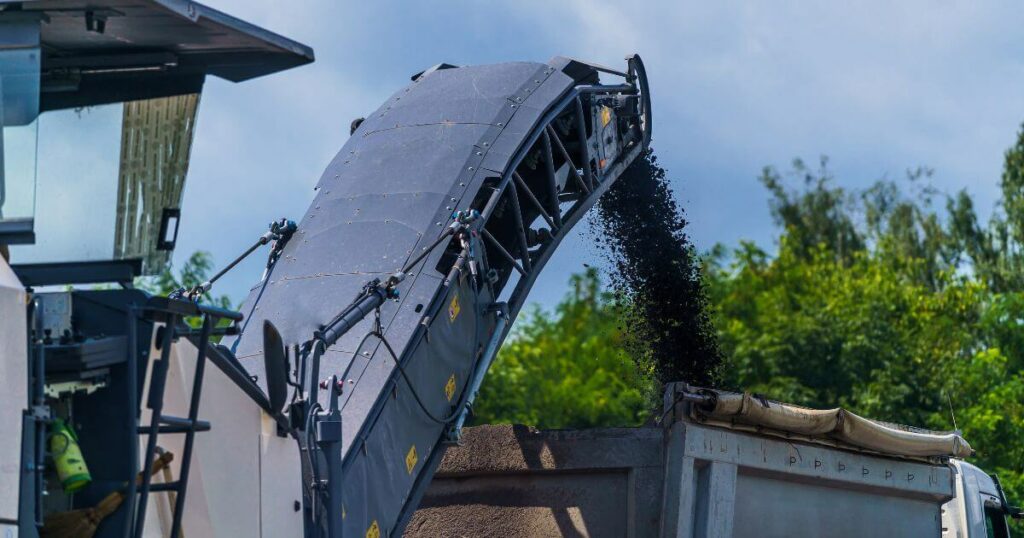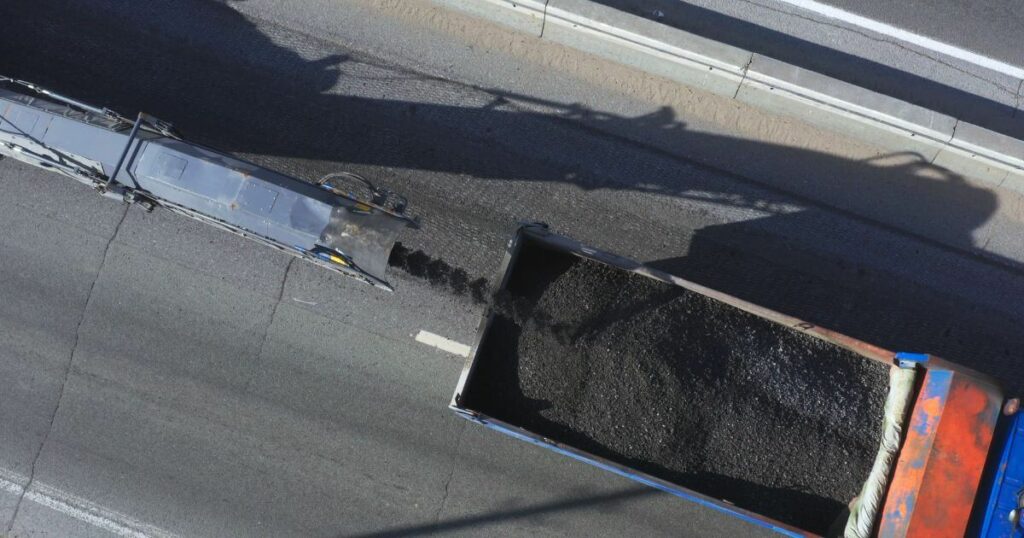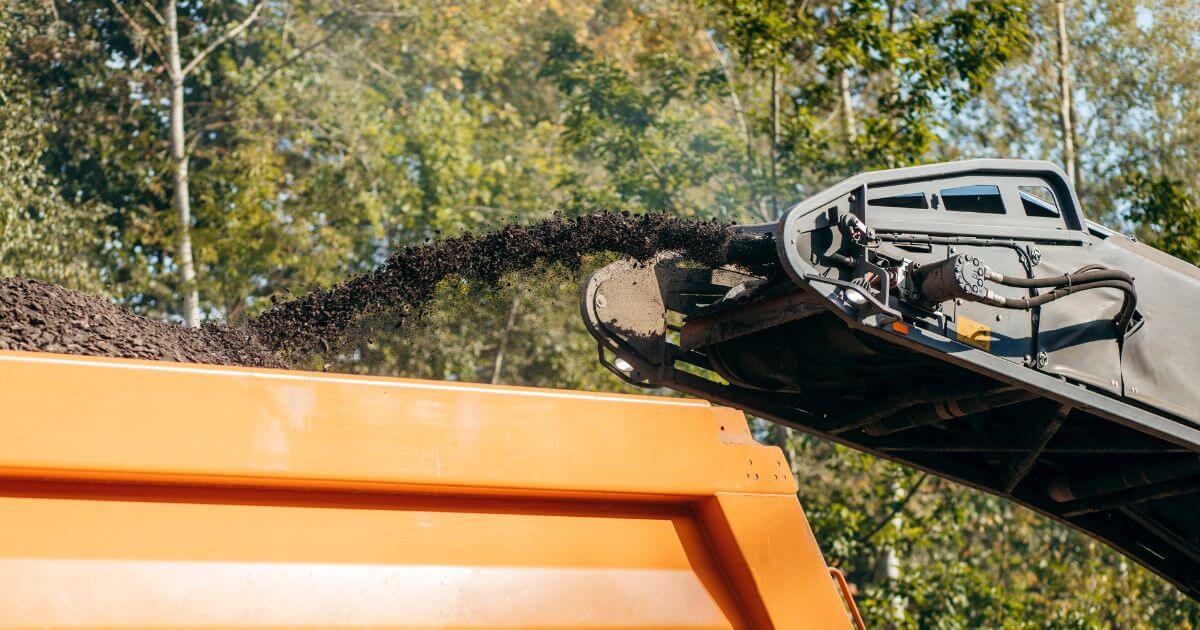In the world of road construction and maintenance, asphalt milling has emerged as a game-changing technique that’s revolutionizing how we approach infrastructure rehabilitation. At Cornerstone Crushing, we specialize in asphalt milling and removal services that enhance the quality and longevity of your roads. This comprehensive guide will take you through everything you need to know about asphalt milling, from its basic principles to its far-reaching benefits and applications.
Understanding Asphalt Milling
Asphalt milling, also known as cold planing, is a controlled process of removing the top layer of an existing asphalt surface. This technique has become increasingly popular due to its efficiency, cost-effectiveness, and environmental benefits.
The Asphalt Milling Process
The process of asphalt milling involves specialized equipment and a series of carefully executed steps:
- Surface Preparation: The area to be milled is cleaned and inspected for any obstructions.
- Milling Machine Operation: A milling machine, equipped with a rotating drum covered in carbide teeth, grinds and removes the top layer of asphalt.
- Material Collection: The removed asphalt, now in the form of small chunks or “millings,” is collected by conveyor belts and loaded into trucks.
- Surface Cleaning: The milled surface is swept and cleaned to prepare for the next phase, whether it’s resurfacing or leaving as-is for a temporary driving surface.
Types of Asphalt Milling
There are several types of asphalt milling, each suited to different project requirements:
- Full-Depth Milling: Removes the entire asphalt layer down to the underlying base.
- Partial Milling: Removes a specified depth of the asphalt surface, typically 1-2 inches.
- Fine Milling: Uses a drum with more teeth to create a smoother surface, often used for leveling or texture correction.
Understanding these types allows project managers to choose the most appropriate method for their specific needs, ensuring optimal results and resource utilization.

Benefits of Asphalt Milling
The advantages of asphalt milling are numerous, making it an attractive option for both large-scale road projects and smaller residential applications.
Cost-Effectiveness
One of the primary benefits of asphalt milling is its cost-efficiency:
- Reduced Material Costs: By recycling existing asphalt, the need for new materials is significantly reduced.
- Lower Transportation Expenses: With less new material required, transportation costs decrease.
- Quicker Project Completion: Milling is generally faster than complete road reconstruction, reducing labor costs and minimizing traffic disruptions.
Environmental Advantages
Asphalt milling is a sustainable practice that offers several environmental benefits:
- Material Recycling: Up to 100% of milled asphalt can be recycled, reducing waste and conserving natural resources.
- Reduced Carbon Footprint: Less new material production and transportation leads to lower greenhouse gas emissions.
- Energy Conservation: Recycling asphalt requires less energy compared to producing new asphalt.
Improved Road Performance
Beyond cost and environmental benefits, asphalt milling can enhance road quality:
- Enhanced Surface Texture: Milling can restore proper texture to worn surfaces, improving skid resistance and safety.
- Better Water Drainage: Correcting surface irregularities improves water runoff, reducing the risk of hydroplaning.
- Preservation of Road Geometry: Milling allows for the removal of surface distortions without changing road height or affecting curbs and manholes.
Applications of Asphalt Millings
The versatility of asphalt millings makes them suitable for various applications beyond just road rehabilitation.
Road Rehabilitation
The primary use of asphalt milling is in road rehabilitation. It allows for:
- Removal of surface distresses like rutting and cracking
- Preparation of the surface for overlay
- Restoration of the proper grade and slope
Driveway Construction
Asphalt millings offer an economical alternative for driveway construction:
- Provides a stable, durable surface
- Offers a more affordable option compared to new asphalt or concrete
- Can be sealed for a smoother finish and enhanced aesthetics
Parking Lot Resurfacing
For commercial properties, asphalt millings are an excellent choice for parking lot resurfacing:
- Cost-effective for large areas
- Minimizes business disruption due to quicker installation
- Provides a sturdy surface capable of withstanding heavy traffic
Temporary Roads and Paths
Asphalt millings are ideal for creating temporary access roads or paths:
- Quick and easy to install
- Can be easily removed or repurposed
- Provides a stable surface for construction vehicles or pedestrian traffic
Asphalt Millings vs. Traditional Materials
To truly appreciate the value of asphalt millings, it’s helpful to compare them with traditional materials like gravel and new asphalt.
Comparison with Gravel
| Factor | Asphalt Millings | Gravel |
| Cost | Generally less expensive | Initial cost may be lower |
| Durability | More durable, especially when compacted | Prone to washouts and rutting |
| Maintenance | Minimal maintenance required | Regular grading and replenishment needed |
| Dust Control | Better dust control | Can be dusty in dry conditions |
| Environmental Impact | Recycled material | Natural resource depletion |
Comparison with New Asphalt
| Factor | Asphalt Millings | New Asphalt |
| Environmental Impact | Lower – uses recycled materials | Higher – requires new materials |
| Installation Process | Simpler, can be DIY for small projects | Requires professional installation |
| Initial Cost | Lower | Higher |
| Finish | Rougher unless sealed | Smooth |
| Long-term Performance | Good when properly installed | Excellent |
These comparisons highlight the unique advantages of asphalt millings, particularly in terms of cost-effectiveness and environmental sustainability.
Installation and Maintenance of Asphalt Millings
Proper installation and maintenance are crucial for maximizing the benefits of asphalt millings.
Proper Installation Techniques
- Site Preparation:
- Remove any vegetation or debris
- Grade and compact the base material
- Ensure proper drainage
- Laying and Compacting Millings:
- Spread millings evenly, typically 2-4 inches thick
- Use a roller compactor to achieve proper density
- Water the surface lightly to aid compaction
- Consider multiple layers for thicker applications
Maintenance Best Practices
- Regular Inspections:
- Check for signs of wear or damage
- Look for areas of poor drainage
- Sealing and Rejuvenation:
- Apply a sealcoat after 6-12 months to improve appearance and durability
- Use an asphalt rejuvenator every few years to restore binder properties
- Prompt Repairs:
- Address any cracks or potholes quickly to prevent further damage
- Regrade if necessary to maintain proper drainage
By following these installation and maintenance practices, property owners can ensure their asphalt milling surface remains functional and attractive for years to come.
Environmental Considerations
The environmental benefits of asphalt milling extend beyond simple material recycling.
Recycling and Sustainability
Asphalt is one of the most recycled materials in the United States. The use of milled asphalt contributes significantly to this recycling effort:
- Up to 100% of asphalt can be recycled
- Recycled asphalt performs as well as or better than new asphalt
- Each year, recycling asphalt saves millions of barrels of oil
Reduction in Landfill Waste
By recycling asphalt through milling:
- Millions of tons of material are diverted from landfills annually
- The need for new landfill space is reduced
- The environmental impact of waste transportation is minimized
Energy Savings in Production
The production of recycled asphalt consumes significantly less energy compared to new asphalt:
- Requires up to 20% less energy for production
- Reduces overall carbon emissions in road construction and maintenance
- Conserves natural resources like aggregate and bitumen
These environmental benefits make asphalt milling an attractive option for eco-conscious project managers and property owners.
Cost Analysis of Asphalt Milling Projects
Understanding the financial aspects of asphalt milling is crucial for making informed decisions.
Initial Costs vs. Long-term Savings
While the upfront costs of asphalt milling can vary, they are generally lower than complete road reconstruction:
- Initial milling costs: $1 to $3 per square foot
- New asphalt installation: $3 to $5 per square foot
However, the real savings come in the long term:
- Reduced need for complete road replacement
- Lower maintenance costs over time
- Extended pavement life
Factors Affecting Project Costs
Several factors can influence the cost of an asphalt milling project:
- Project size and scope
- Depth of milling required
- Local material and labor costs
- Equipment availability
- Site accessibility
- Time constraints and scheduling
Return on Investment
The ROI for asphalt milling projects can be substantial:
- Extended pavement life by 5-10 years
- Reduced long-term maintenance costs
- Improved road safety, potentially reducing accident-related costs
By considering these financial aspects, decision-makers can better understand the value proposition of asphalt milling for their specific projects.
Future of Asphalt Milling Technology
The field of asphalt milling continues to evolve, with new technologies and techniques emerging to improve efficiency and sustainability.
Emerging Trends
- Automated Milling Machines: GPS-guided milling for improved precision and efficiency
- Real-time Quality Control: On-board sensors to monitor milling depth and surface texture
- Dust Control Innovations: Advanced suppression systems for improved air quality during milling
Potential Innovations
- Green Binding Agents: Development of bio-based rejuvenators for recycled asphalt
- Cold In-Place Recycling: Advancements in on-site recycling techniques
- Smart Road Materials: Integration of sensors in recycled asphalt for real-time condition monitoring
These advancements promise to make asphalt milling even more efficient, cost-effective, and environmentally friendly in the future.
Choosing an Asphalt Milling Contractor
Selecting the right contractor is crucial for the success of any asphalt milling project.
Qualifications to Look For
- Proper licensing and insurance
- Extensive experience in asphalt milling
- Modern, well-maintained equipment
- Positive references and reviews
- Knowledge of local regulations and best practices
Questions to Ask Potential Contractors
- How long have you been in the asphalt milling business?
- Can you provide examples of similar projects you’ve completed?
- What type of equipment will you use for my project?
- How do you ensure quality control during the milling process?
- What safety measures do you have in place?
- How do you handle recycling of milled materials?
Importance of Experience and Reputation
Choosing an experienced contractor with a solid reputation can:
- Ensure high-quality work
- Minimize project delays and complications
- Provide peace of mind throughout the project
- Potentially save money by avoiding costly mistakes or rework
By carefully vetting and selecting a qualified contractor, project owners can significantly increase the likelihood of a successful asphalt milling project.

Paving the Way to Sustainable Road Rehabilitation with Cornerstone Crushing
Asphalt milling stands out as a sustainable, cost-effective, and versatile solution for road rehabilitation and various paving applications. Its benefits extend far beyond simple resurfacing, offering environmental advantages, improved road performance, and significant cost savings over traditional methods.
As we’ve explored in this guide, the applications of asphalt milling are diverse, ranging from large-scale highway projects to residential driveways. The process not only breathes new life into deteriorating surfaces but does so in a way that conserves resources and reduces environmental impact.
The future of asphalt milling looks bright, with ongoing technological advancements promising even greater efficiency and sustainability. As more project managers and property owners become aware of its benefits, we can expect to see increased adoption of this innovative technique.
Whether you’re a road construction professional, a property manager, or a homeowner considering driveway options, asphalt milling offers a compelling solution that balances performance, cost, and environmental responsibility.
Ready to revitalize your roads with sustainable, cost-effective asphalt milling? Cornerstone Crushing is your trusted partner in pavement restoration. Our expert team and state-of-the-art equipment ensure top-quality results for projects of any scale. Contact Cornerstone Crushing today for a free consultation and discover how we can transform your aging surfaces into smooth, durable, and eco-friendly pavements.
Frequently Asked Questions
- What is the average lifespan of an asphalt milling surface? With proper installation and maintenance, an asphalt milling surface can last 7-10 years or more, depending on traffic volume and environmental conditions.
- Can asphalt millings be used in cold climates? Yes, asphalt millings can be used in cold climates. They actually perform well in freeze-thaw cycles, as the loose structure allows for some flexibility. However, proper drainage is crucial to prevent ice formation.
- How does the cost of asphalt milling compare to traditional resurfacing? Asphalt milling typically costs 30-40% less than traditional resurfacing methods. The exact savings depend on project size, location, and specific requirements.
- Are there any environmental concerns with using asphalt millings? While asphalt millings are generally considered environmentally friendly due to their recycled nature, there can be concerns about potential leaching of hydrocarbons. However, studies have shown that properly installed asphalt milling surfaces pose minimal environmental risk.
- Can I install asphalt millings myself, or should I hire a professional? For small projects like residential driveways, DIY installation is possible with the right equipment. However, for larger projects or those requiring precise grading, it’s recommended to hire a professional to ensure proper installation and performance.
- How soon can traffic resume on a newly milled and resurfaced road? Light traffic can usually resume immediately after compaction. For heavy traffic, it’s best to wait 24-48 hours to allow the surface to fully settle and harden.
- What maintenance is required for asphalt milling surfaces? Maintenance is generally minimal but includes regular inspections, prompt repair of any damage, and occasional regrading if necessary. Applying a sealcoat after 6-12 months can enhance durability and appearance.
- Are asphalt millings suitable for high-traffic areas? Yes, when properly installed and compacted, asphalt millings can withstand high traffic. For very high-traffic areas, an additional layer of hot mix asphalt over the millings may be recommended for optimal performance.
- How does weather affect the installation of asphalt millings? Dry, mild weather is ideal for installation. Rain can make compaction difficult, while extreme heat can cause the material to become too soft. Cold temperatures below freezing can make the material too stiff to work with effectively.
- Can asphalt millings be used for other applications besides roads and driveways? Absolutely! Asphalt millings are versatile and can be used for parking lots, walking trails, temporary access roads, and even as a base material for other types of paving.
Remember, while this FAQ covers many common questions, each project is unique. For specific advice tailored to your situation, it’s always best to consult with a qualified asphalt professional.


